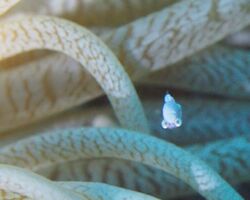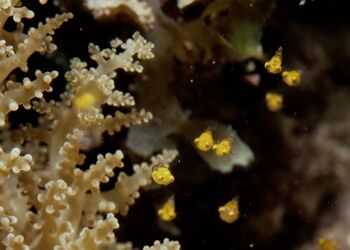Biology:Idiomysis
| Idiomysis | |
|---|---|

| |
| Idiomysis sp. | |
| Scientific classification | |
| Kingdom: | |
| Phylum: | |
| Subphylum: | |
| Class: | |
| Order: | |
| Family: | |
| Subfamily: | Mysinae
|
| Tribe: | Anisomysini
|
| Genus: | Idiomysis W. Tattersall, 1922[1]
|
| Species | |
|
See text
| |
Idiomysis is a genus of small mysids found in warm, shallow waters of Indian Ocean (including Red Sea) and Pacific.[2]
Anatomy
Mysids from the genus Idiomysis are just few millimeters length; their cephalothorax is gibbous and robust whereas the abdomen is characteristically curled up behind[1].[3] When compared with other mysids, Idiomysis has short antennae, relatively big eyes and small, usually unarmed telson[1], however a single species, I. diadema, possesses a pair of short terminal spines[3].
Systematics
There are six species described so far in the genus[2]:
- Idiomysis diadema Wittmann, 2016
- Idiomysis inermis W. Tattersall, 1922
- Idiomysis japonica Murano, 1978
- Idiomysis mozambica Deprez, Wooldridge & Mees, 2001
- Idiomysis robusta Connell, 2008
- Idiomysis tsurnamali Bacescu, 1973.
Ecology
Idiomysis live in the small groups (called swarms) of 5 to more than 40 individuals, which hover over sea bottom during a day and probably feed on the seafloor on the nighttime.[4] All known species are found in the shallow coastal waters, however they inhabit different niches and can be found on coral reefs, seaweeds, rocks or sandy bottoms[4]. Two species – I. inermis and I. tsurnamali – are known for commensal relationship with the sea anemones[4], whereas I. diadema is associated with the sea urchin Diadema[3]. There are also reports of Idiomysis hovering above upside-down jellyfish, Cassiopea[4]. Possibly mysids gain protection and/or food supply from this relationship, however the exact nature of the relation has not been studied[4].
Distribution
The described species are known from Red Sea (I. diadema and I. tsurnamali), Mozambique Channel (I. mozambica), Gulf of Mannar (I. inermis), western coast of Australia (I. inermis), East China Sea (I. japonica) and western coast of South Africa (I. robusta)[2].
References
- ↑ 1.0 1.1 1.2 Walter Medley Tattersall (1922). "Indian Mysidacea". Records of the Indian Museum 24: 445–504.
- ↑ 2.0 2.1 2.2 "Mysida". WoRMS. World Register of Marine Species. 2016. http://www.marinespecies.org/aphia.php?p=taxdetails&id=161513.
- ↑ 3.0 3.1 3.2 Karl J. Wittmann (2016). "Description of Idiomysis diadema sp. nov. (Mysida, Mysidae, Anisomysini), associated with Diadema urchins in the Red Sea; with nomenclatorial notes on its genus". Crustaceana 89 (5): 611–623. doi:10.1163/15685403-00003542.
- ↑ 4.0 4.1 4.2 4.3 4.4 R. N. Bhaduri; A. L. Crowther (2015). "Association of the mysid Idiomysis inermis with the sea anemone Stichodactyla haddoni in Moreton Bay, Australia". Marine Biodiversity 46 (3): 707–711. doi:10.1007/s12526-015-0408-7.
External links
Wikidata ☰ Q4513446 entry
 |




